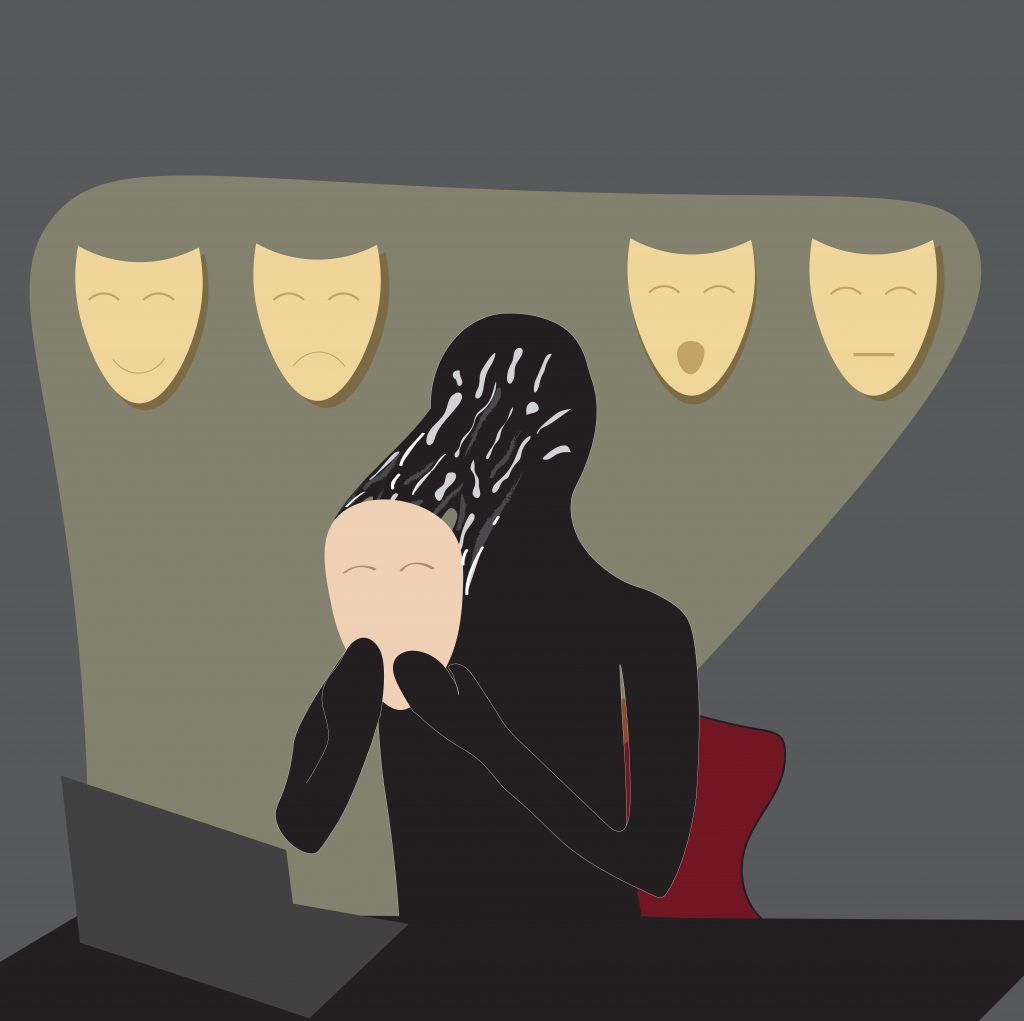
Experts work to destigmatize mental illness and addiction
Counselors and people in recovery discuss the impact of harmful rhetoric on addiction perception.

he professor who assigns hours of homework a night is insane, and a friend who binge-watches Netflix refers to themself as a junkie. Alfred Hitchcock’s 1960 thriller Psycho amassed around 400 million dollars in box office sales when it debuted and blazed the trail for horror movies featuring a mentally ill villain. Smash-hit television series like Breaking Bad and Euphoria trivialize and stereotype substance use and addiction while cult classic The Devil Wears Prada teases disordered eating in the fashion industry.
Upon first glance, these things may appear unrelated and irrelevant, harmless phrases or characters, with little to no long-lasting impact on the human experience. But, Matthew Shapiro, public engagement coordinator with the National Alliance on Mental Illness (NAMI) in New York, challenges this rhetoric.
To Shapiro, these depictions and language aren’t acceptable — they are disinformation — and they catalyze mental health and addiction stigma in the United States and beyond.
“This disinformation leads people to be scared of people living with a mental illness or addiction,” Shapiro said. “That only makes people who do live with a mental illness more uncomfortable to talk because you don’t want to be judged as violent or crazy.”
Shapiro said he’s experienced this judgment first-hand on his own mental health recovery journey and in his work with NAMI. He recalled the tongue-in-cheek jeers his peers made about therapy, or head shrinking, and said they made him feel like he couldn’t seek therapy, out of fear of seeming weak.
This experience of internalized shame isn’t unique to Shapiro, according to Dr. Brenda Curtis at the Perelman School of Medicine at the University of Pennsylvania. Instead, Curtis argues it is reflective of a larger stigmatization within mental health — that mental illness and substance use are a moral failing — and that those who are struggling should be able to alleviate their suffering if they choose to.
“People adopt a less than approach to recovery and an overall self-view,” Shapiro said. “You feel like you’re less than because that’s what you’ve been told by the media and all this misinformation.”
The less than approach manifested itself in Ashley Livingston’s life, especially on her recovery journey from opiate use, she said. Having been incarcerated at 19, shot and dealt heroin and overdosed on prescription opiates, she is no stranger to the label “addict.”

But, Livingston refuses to allow that label and stigma to define her. She’s rebuilt her life from the ground up and introduces herself as a woman living in long-term recovery — what she calls a silent protest of the stigmatized, biased view of addiction — and a reclamation of her power.
“I am an individual in long-term recovery and what that means for me is I haven’t used a mood or mind-altering substance in nine years,” Livingston said.
Now Livingston works as a recovery advocate at the Hope and Healing Recovery Community Center and Friends of Recovery New York. There she holds language training, works with fellow recovery peers and advocates for improved policy and legislation at the state and federal levels.
“I talk about being culturally competent. I say ‘it’s okay for you to identify as an addict when you’re in the church basement. But when you’re in public, you’re a person in recovery,’” Livingston said.
Cultural competence is a movement in recovery communities, Livingston said, that is fighting to redefine recovery narratives and language through individuals actually in recovery.
“Sometimes, I’ll identify myself as a heroin addict. But I make that choice,” Livingston said. “No one tells me how to define myself. And if we don’t tell society how to define us, they’re going to silence us, use degrading terms and spread disinformation.”
Shapiro echoed similar sentiments as Livingston, explaining that though the state of New York is considerably more progressive than other states in its advocacy and emphasis on mental health, negative, problematic language and media portrayals remain the most dominant voice.
“There are so many positive aspects of what you can learn in recovery and how you use that resilience you built as a person with mental illness,” Shapiro said. “But we are combatting over 150 years of disinformation that is woven into our cultural fabric, so we have a lot to overcome.”
Livingston combats disinformation when she works with care providers, diligently fighting “clean” versus “dirty” toxicology and urging them to merely refer to patients as being present or absent for a given substance.
If a person refers to an overdose prevention center as a “shooting gallery,” she corrects them. She explains how that term is harmful and advocates for news organizations to use inclusive language and imagery alongside stories of recovery, instead of the typical needles, bongs and derogatory language.
“If you love something and you want it to grow, you call it a flower. If you hate something and you want it to die, you call it a weed,” Livingston said. “Words have immense power and how we speak shapes how someone will perceive something.”
But, according to Shapiro, loaded language isn’t the only form of mental health disinformation that prevents people from seeking help. Shapiro explained that many people fail to recognize they need help since, according to statistics, they aren’t sick enough to need it.
This was the case for Courtney Wright, a model ambassador for NAMI NYS, who was bullied relentlessly at school because of her appearance. Wright said that, after enduring years of being spat at and kicked by her peers, she internalized the abuse, and it manifested as anxiety, depression and an eating disorder.
Wright recalled that because her body size didn’t reflect how someone struggling with disordered eating looked like in the media portrayal of how ‘sick’ a person with an eating disorder is meant to look, her experience with bulimia was invalidated.
“People would say ‘you look really great, you look skinny … I was only 98 pounds,” she said. “But, because we use the BMI scale, the whole spectrum of weight is disproportionate… and it makes people like me feel like there is something wrong with our bodies.”
The body mass index (BMI) is a standard convention in American medicine used to gauge a person’s weight relative to their height in order to determine if they’re obese. It is intended to account for the nuance of body mass given the variation in human height but has been proven to be a flawed system of measurement, particularly for people with eating disorders. BMI creates a blanket approach to body mass, instead of accounting for the differences in weight between muscle and fat and how men and women carry their body mass differently.
For someone like Wright, a 4-foot-11-inch woman, the BMI deems her “obese” at 120 pounds. So, even when her life became confined to incessant binge and purge cycles, the disinformation rooted in BMI made her believe she wasn’t doing her body any harm.
“I didn’t realize how bad it had gotten until I needed to get oral surgery, dentures, to replace my teeth from all the acid erosion in my mouth,” Wright said. “I got to the point where my doctors told me I was going to die.”
Wright’s story is not the exception: it’s become the norm with eating disorders. Disinformation perpetuating a stereotype of who is ‘sick enough’ to truly have an eating disorder causes those living with eating disorders to feel minimized in their experiences because they don’t neatly fit the textbook measurements of how an illness looks.
This phenomenon and disinformation are so rampant that Dr. Jennifer L. Gaudiani, an eating disorder specialist and founder of the Gaudiani Clinic, published her book Sick Enough to accentuate this disinformation, and how it restricts patients from asking for help when they are struggling.
“It took me so long to use the words ‘eating disorder’ because I didn’t believe I was sick enough to have one,” Wright said. “I could go all day and not eat and then binge and purge at night, but I wasn’t too big or too small so I thought I was okay.”
In Livingston’s case, if she were “addicted enough” to heroin, she said she would’ve been offered recovery resources sooner. She explained that the first time she sought medical care for her heroin dependency, she was only kept at the hospital for a weekend to detox and was sent back home at the end of the weekend. When she asked why this was, the care team explained her withdrawal symptoms weren’t severe enough to warrant a longer stay.
“The doctor literally said to my mom, ‘Well, she’s not that bad. She’s not shooting up or selling her ass.’ They told her she could bring me back if I ever got sick enough,” Livingston said. “They didn’t give me what I needed so I just went back to using. I wonder all the time if I ever would’ve gotten to the dark place I did if I was given care when I asked for it the first time.”
Shapiro said that, in his role at NAMI, he’s heard countless stories like Livingston and Wright’s where the expected display of symptoms or behavior doesn’t align with the conventional, accepted portrayals of that given illness and therefore goes untreated. But, he also said that if organizations like NAMI and people like Livingston and Wright continue their advocacy work, culture is capable of progress and new mental health narratives, instead of disinformation.
Transforming the mental healthcare field into one that is person-centered is how Shapiro said he believes true, destigmatized care will be made possible for all patients. Merely based upon human nature, Shapiro said that all people — even with the same diagnosis — will experience their mental illness and recovery differently, and thus, accessible, person-centered care could make the difference between life and death for a patient.
“At the end of the day, it’s about viewing people as people,” Shapiro said. “You’re not schizophrenic, you’re a person living with schizophrenia. You are not your diagnosis, and no one can ever label you or define who is or isn’t in need of care.”
Unlike a physical disability or illness that may require something like a wheelchair or create visible symptoms, mental illness insidiously lurks beneath the surface. Shapiro said this makes it an inherently lonely experience. But, in combating disinformation and stigma, Shapiro said something as simple as answering honestly when asked “how are you” can chip away at the shame associated with mental health and bring people together with empathy.
In Wright and Livingston’s cases, both said they intend to break the cycle of mental health shame and disinformation by sharing their truths — unafraid of being called crazy, insane, or an addict — and continuing to transform their struggles into strength.
“I imagine my mental scars like a hot branding iron that I put down my throat and survived … anytime I consume something, I remember and feel that pain but no one else can see my scars because it’s inside,” Wright said. “That’s why I speak up, for other people feeling that burn. Because we don’t need to feel that alone.”
